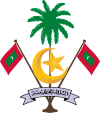Traditionally children aged three and up in the Maldives were educated in traditional schools known as "Kiyavaage" or "Edhurge", generally using a single large room or the shelter of tree. The children learned simple arithmetic, Dhivehi and some Arabic, and practiced reciting the Qur'an. These private schools no longer exist, as western style schools replaced them in the 1980s-1990s.
The first western-style school in the Maldives is Majeediyya School, a secondary established in 1927. The school was originally co-educational, but it was felt necessary to create a second school for girls (Aminiya School) in 1944.
Based on a study by educational advisors from UNESCO, the Government of Maldives began implementation of the Educational Development Project on 6 October 1976. This Project constituted a comprehensive programme of educational development comprising Expansion of Primary Education, Teacher Training, Curriculum Development, Educational Radio, Community Education Programme for Adult Education and Textbook Development and Printing. The first school under this project was opened in Baa Atoll Eydhafushi in March 1978 followed by another two in N. Manadhoo and HDh. Kulhudhuffushi in March 1979. School construction was continued in all atolls and was later complemented by Primary Schools construction project by Japan. Curriculum Development began in 1976, while Teacher Training began in 1977. Simultaneously, other programmes were introduced and continued through the 1970s and until the mid-1980s from where on the First Ten Year Master Plan for Educational (1986-1995) began implementation. Second Master Plan was implemented 1996–2005. These were the bases of educational development in the Maldives begun by the government of President Nasir continued by President Gayoom.
As of 2002, the President's Office claimed that universal primary education has almost been achieved and the literacy rate had improved from 70 percent in 1978 to 98.82 percent. In 2005, there were 106,220 students in schools, or 40% of the total population.
Higher education
A National University Act was passed in January 2011 to establish the first university in the Maldives. Institutions offering higher education in the Maldives are:
- Maldives National University, which was previously known as the Maldives College of Higher Education. The college had offered 95% of the post-secondary education in the Maldives
- Cyryx College
- Mandhu College, which provides tertiary education to lower and higher secondary school leavers.
- Villa College , which has offered degree courses in computing and IT since 2007.
- MAPS College
- Ixcel Centre for Professional Studies
- Avid College
- Maldives Business School
- Maldives Polytechnic
- Islamic University of Maldives
- Clique College
See also
References
- ^ Status of Women: Maldives. Office for Women's Affairs, UNESCO Principal Regional Office for Asia and the Pacific (Thailand). Regional Unit for the Social and Human Sciences in Asia and the Pacific (Report). Thailand. 1989. p. 22. Retrieved 2022-11-28.
- "History". Majeediyya School. Retrieved 27 July 2024.
- Malsa, Mariyam (28 November 2019). "Aminiya School celebrates diamond jubilee". The Edition. Retrieved 27 July 2024.
- "Maldives to get first-ever university with University Act". Haveeru Daily. 17 January 2011. Archived from the original on 17 June 2011. Retrieved 23 January 2011.
- ^ Akhtar, Shahid; Arinto, Patricia (2010). Digital Review of Asia Pacific 2009-2010. IDRC. p. 10. ISBN 978-81-321-0084-3.
- "CIMA expands into the Maldives". The Island. Sri Lanka. 3 November 2007. Archived from the original on 1 December 2017. Retrieved 23 January 2011.
- "Cabinet decides to establish Maldives Polytechnic". The President's Office. Archived from the original on 31 October 2023. Retrieved 31 October 2023.
External links
- Developing Education Master Plan (2006 - 2015) (dhivehiobserver.com)
- https://web.archive.org/web/20050407060243/http://www.hellomaldives.com/maldives/education/contents.htm hellomaldives.com
- http://www.themaldives.com/Maldives/Maldives_education.htm Archived 2006-03-29 at the Wayback Machine theMaldives.com
| Maldives articles | |||
|---|---|---|---|
| History |  | ||
| Geography | |||
| Politics | |||
| Economy | |||
| Society | |||